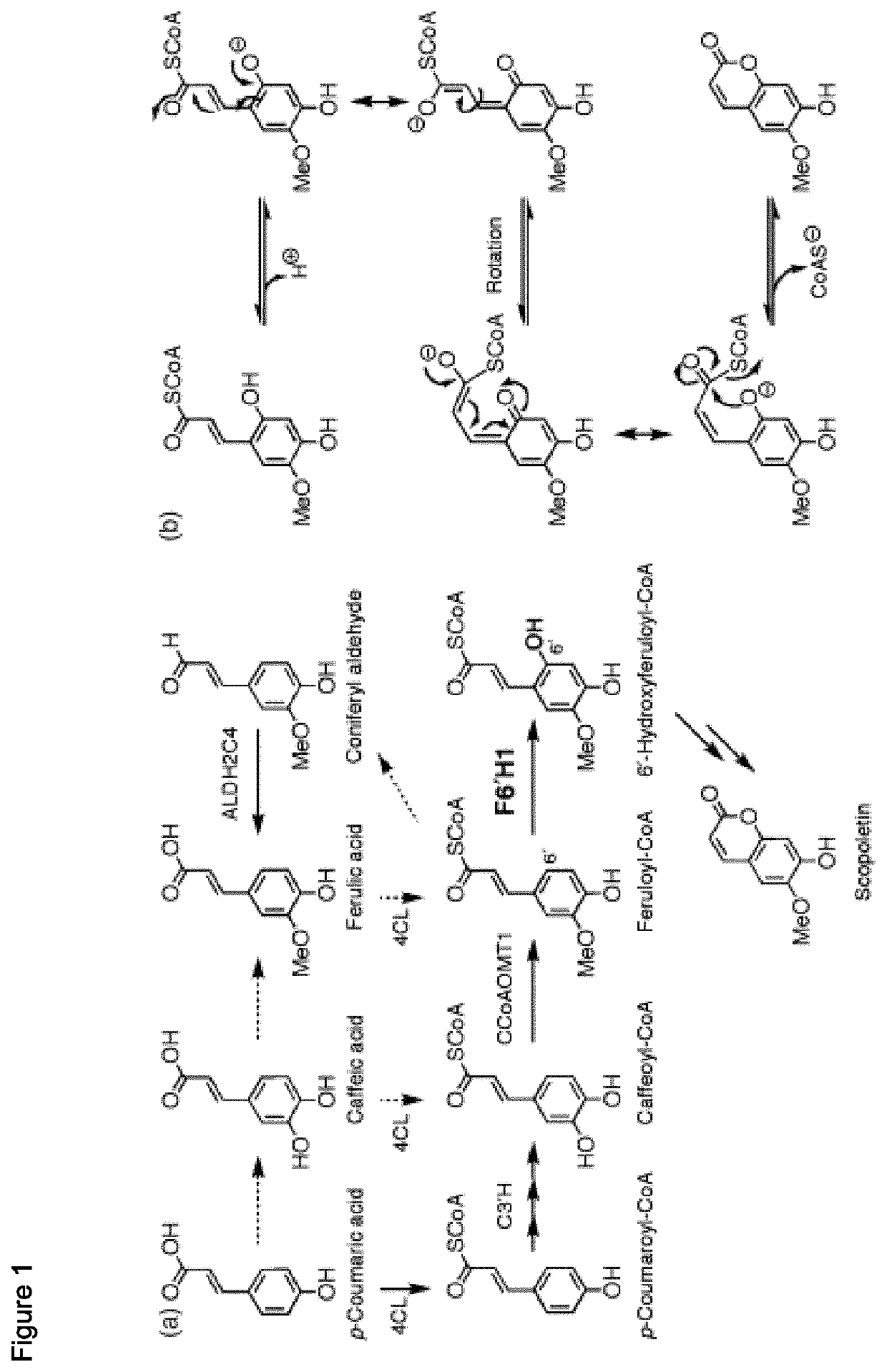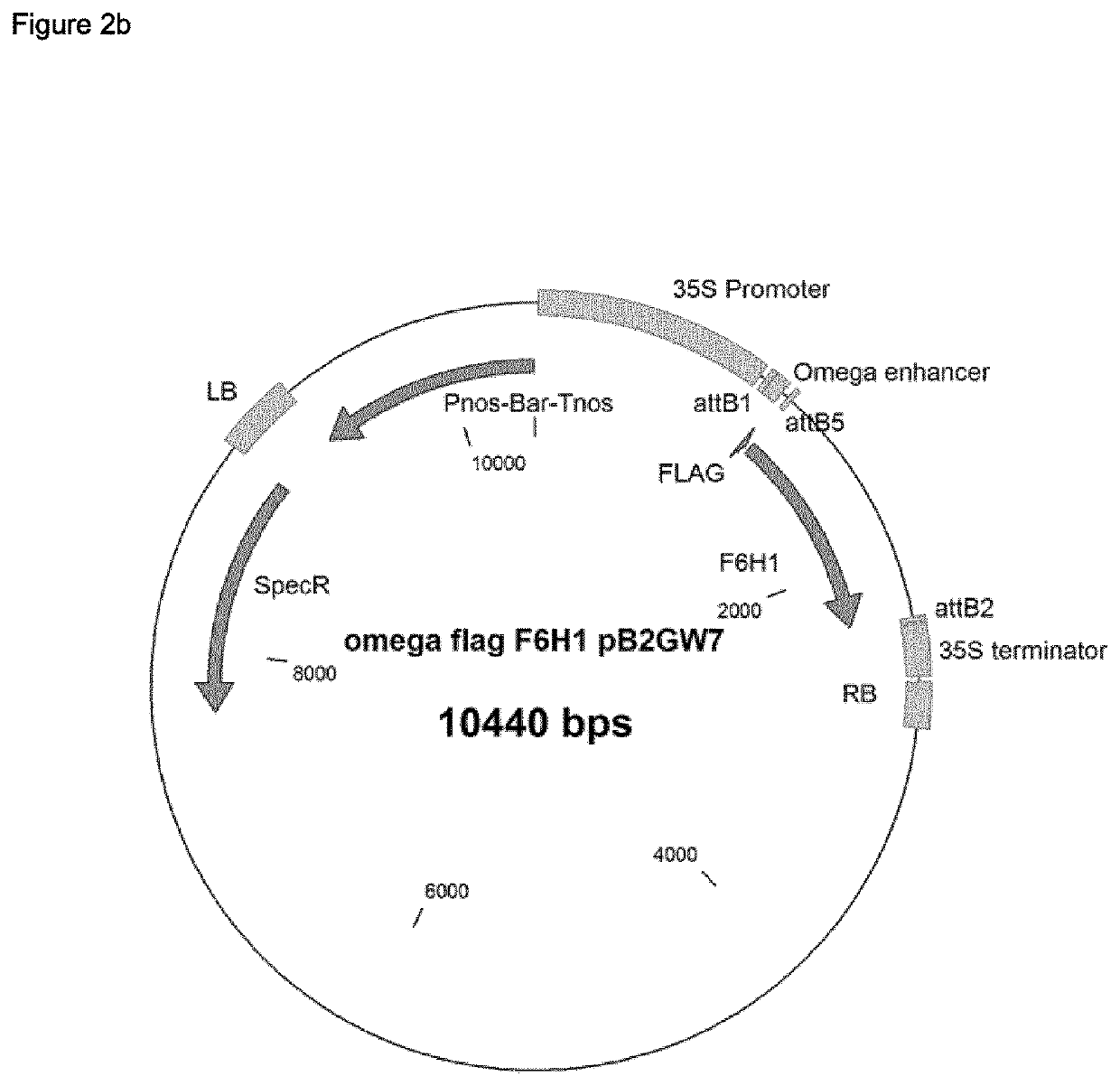Method of increasing resistance against soybean rust in transgenic plants by increasing the scopoletin content
a technology of scopoletin and transgenic plants, which is applied in the direction of biochemistry apparatus and processes, plant peptides, enzymes, etc., can solve the problems of low yield, serious hampered development or death of host, and high susceptibility to epidemic-like spreading of diseases, so as to reduce the symptoms of soybean rust disease and diseased leaf area
- Summary
- Abstract
- Description
- Claims
- Application Information
AI Technical Summary
Benefits of technology
Problems solved by technology
Method used
Image
Examples
example 1
General Methods
The chemical synthesis of oligonucleotides can be affected, for example, in the known fashion using the phosphoamidite method (Voet, Voet, 2nd Edition, Wiley Press New York, pages 896-897). The cloning steps carried out for the purposes of the present invention such as, for example, restriction cleavages, agarose gel electrophoresis, purification of DNA fragments, transfer of nucleic acids to nitrocellulose and nylon membranes, linking DNA fragments, transformation of E. coli cells, bacterial cultures, phage multiplication and sequence analysis of recombinant DNA, are carried out as described by Sambrook et al. Cold Spring Harbor Laboratory Press (1989), ISBN 0-87969-309-6. The sequencing of recombinant DNA molecules is carried out with an MWG-Licor laser fluorescence DNA sequencer following the method of Sanger (Sanger et al., Proc. Natl. Acad. Sci. USA 74, 5463 (1977).
example 2
Cloning of Overexpression Vector Constructs for Transient N. benthamiana Transformation
To obtain cDNA, RNA was extracted from leaf tissue of Arabidopsis thaliana pen2 mutants that had been inoculated with P. pachyrhizi two days before harvest. cDNA was produced using RevertAid H minus reverse trancriptase (Thermo Scientific). All steps of cDNA preparation and purification were performed according as described in the manual.
The SEQ-ID 1-sequence (F6H1) was amplified from the cDNA by PCR as described in the protocol of the Phusion High-Fidelity DNA Polymerase (Thermo Scientific) hot-start, Pfu Ultra, Pfu Turbo or Herculase DNA polymerase (Stratagene). The composition for the protocol of the Pfu Ultra, Pfu Turbo or Herculase DNA polymerase was as follows: 1×PCR buffer, 0.2 mM of each dNTP, 100 ng cDNA of Arabidopsis thaliana (var Columbia-0), 50 pmol forward primer, 50 pmol reverse primer, 1 u Phusion hot-start, Pfu Ultra, Pfu Turbo or Herculase DNA polymerase.
The amplification cycles ...
example 3a
Transient Transformation of N. benthamiana Leaves
Transient transformation of N. benthamiana leaves was done according to a slightly modified protocol from Popescu et al. 2007 (Popescu, S. C., Popescu, G. V., Bachan, S., Zhang, Z., Seay, M., Gerstein, M., Snyder, M., and Dinesh-Kumar, S. P. (2007). Differential binding of calmodulin-related proteinsto their targets revealed through high-density Arabidopsis protein microarrays Proc Natl Acad Sci USA 104, 4730-4735.) A single Agrobacterium (strain AGL01) carrying a DNA construct of interest (see FIGS. 2a and 2b) was cultured in YEB medium with appropriate antibiotics for 14-16 h at 28° C. Cells were harvested by centrifugation (5000 rpm 10 min), resuspended to an OD of 0.4-0.8 in buffer containing 10 mM MgCl2, 10 mM MES pH 5.6 and 150 μM acetosyringone and incubated for 2-5 h at room temperature. Agrobacteria transformed with the DNA construct of interest were then mixed with an equal volume of Agrobacteria containing the p19 silencing...
PUM
| Property | Measurement | Unit |
|---|---|---|
| resistance | aaaaa | aaaaa |
| size | aaaaa | aaaaa |
| race specific resistance | aaaaa | aaaaa |
Abstract
Description
Claims
Application Information
 Login to View More
Login to View More - R&D
- Intellectual Property
- Life Sciences
- Materials
- Tech Scout
- Unparalleled Data Quality
- Higher Quality Content
- 60% Fewer Hallucinations
Browse by: Latest US Patents, China's latest patents, Technical Efficacy Thesaurus, Application Domain, Technology Topic, Popular Technical Reports.
© 2025 PatSnap. All rights reserved.Legal|Privacy policy|Modern Slavery Act Transparency Statement|Sitemap|About US| Contact US: help@patsnap.com



